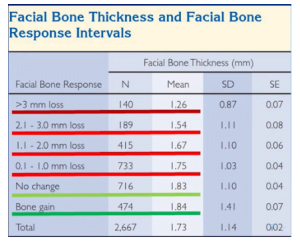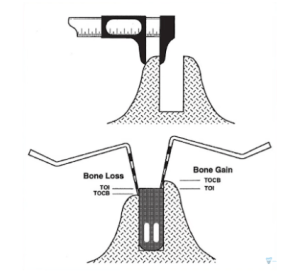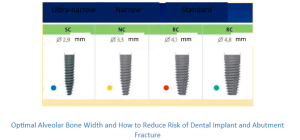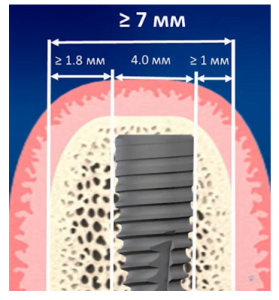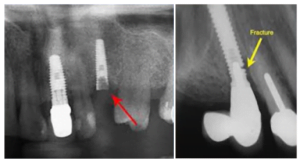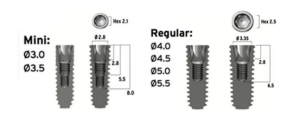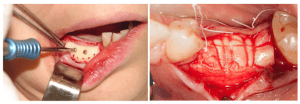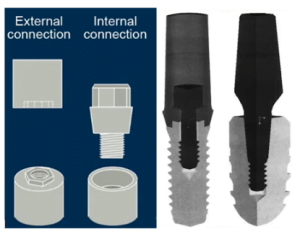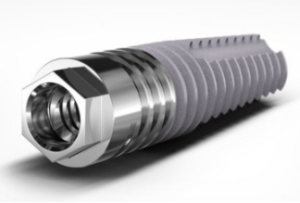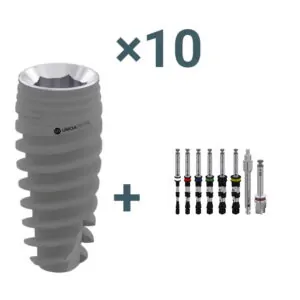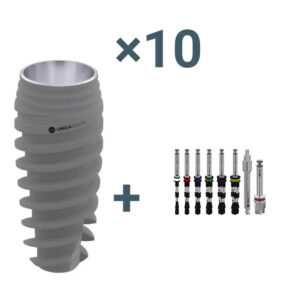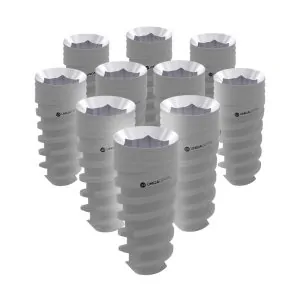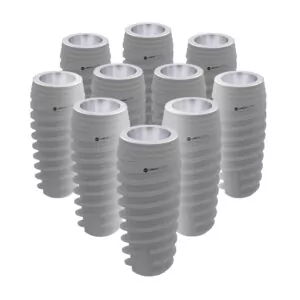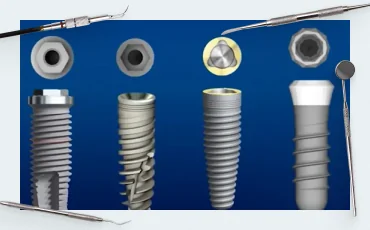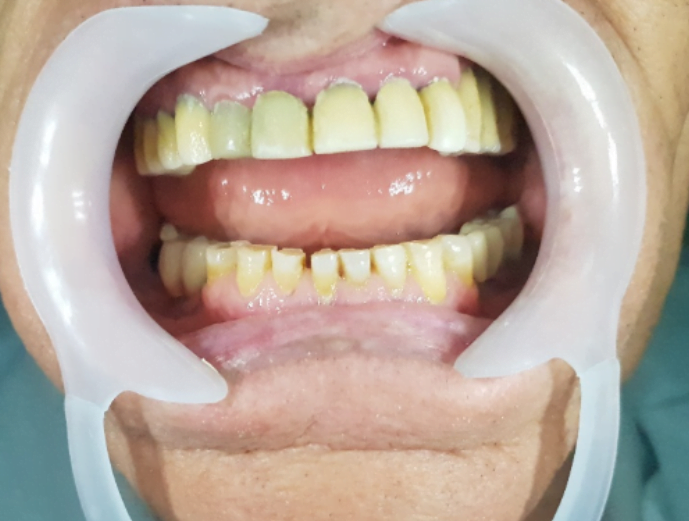Implant Diameter: How to Choose the Best One
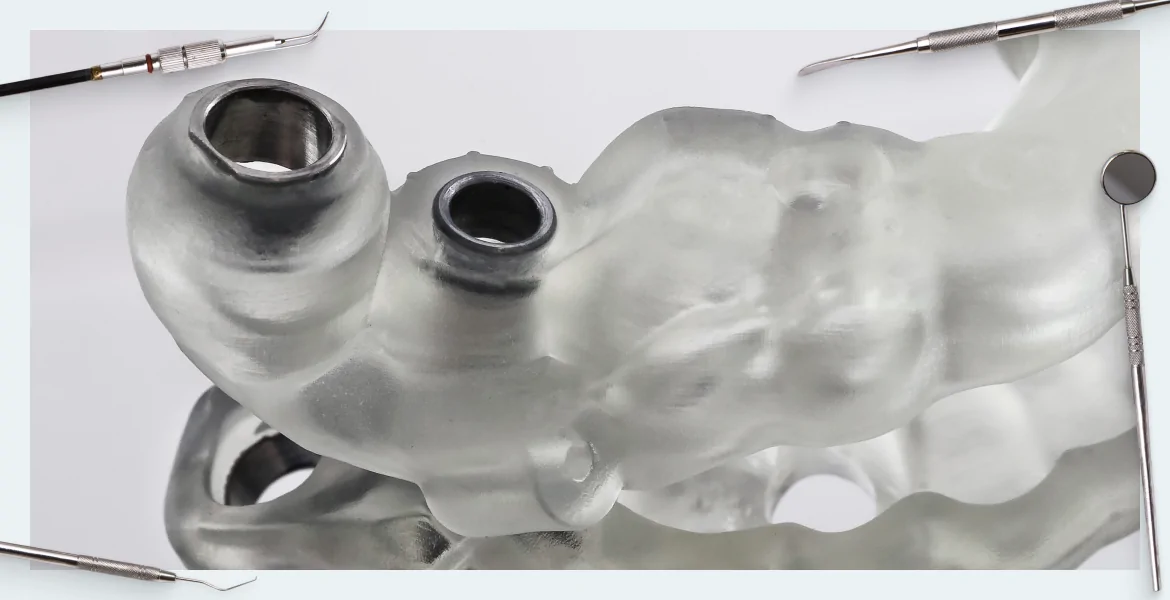
Contents
In this article, we will talk about the dental implant diameter, as well as the design and strength of different types with the same diameter. For better or worse, there is no perfect solution for all cases. We will analyze medical cases and recommendations on how to choose diameter of the dental implant for different parts and states of alveolar bones. We will also consider the structural features that make an implant of 3 mm diameter or less high strength.
How Thick the Bone around the Implant Should Be
Obviously, for the implant to be securely fitted, it needs to be surrounded by a sufficient thickness of bone. What bone thickness should be considered to be sufficient? Not long ago, treatment guidelines and textbooks considered sufficient thickness of the bone to be 1-1.5 mm on all sides. Nowadays, there are studies that offer new recommendations, which are:
- the thickness of the bone on the facial (outer) side should be 2 mm (minimum of 1.8 mm);
- the thickness of the bone on the inside should be at least 1 mm.
The new recommendations are based on a major study that was published recently, see the title below:
This study showed that there was an alveolar bone loss when the thickness of the facial bone ranged from 1 to 1.4 mm. With the thickness range of 1.4-1.7 mm, the degree of bone loss decreased. Starting with a thickness of 1.8, bone loss was the smallest or there was no bone loss at all. Moreover, starting from this thickness, there was a gain in the bone volume, see the table below.
Observations and clinical experience of other specialists also confirm that the “critical” thickness is about 2 mm. This greatly reduces the probability of cortical bone rarefication and exposure of the abutment collar and the upper edge of the implant. When there is a loss, its degree decreases, and most importantly, only with this thickness index, there is sometimes an increase in the height of the alveolar crest in response to the load on the masticatory system.
During the study, experts took measurements at the implantation stage and after 4-6 months, when the full osseointegration was completed. They measured the thickness of the surrounding walls around the implant and then the loss or gain of the bone of the alveolar crest, see the figure below.
Which Implants Are Called “Thin” and “Thick”
There is no clear classification of which implants are thin and which are thick. They only can be divided approximately in the diameter range from 2.9 to 5.5mm. Ultra-narrow implants are implants with a diameter of less than 3mm, implants with a diameter from 3.0 to 3.75 are considered simply to be narrow, see the figure below. Implants with a diameter of 4-4.8mm in all classifications are considered the gold standard for most medical cases, including cosmetic aspects. Implants larger than 5.0mm are conventionally considered to be “thick”. This is evidenced by the statistics of sales of elements for dental prostheses – medium or standard implants hold the largest market share.
Optimal Alveolar Bone Width and How to Reduce Risk of Dental Implant and Abutment Fracture
For example, if we need to have at least 2 mm on the facial side and 1 mm on the internal side, then, for the implant with a diameter of 4 mm to be placed, the width of the alveolar crest needs to be at least 7 mm. However, 7 millimeters or more is not always available, and many specialists decide to place smaller diameter implants. Let’s analyze the implications of such a decision.
When placing narrow implants, there is an increased risk of fracture of the top of the implant together with a straight abutment.
To understand the root of the problem, let’s take a look at dental implants of conventional design with an internal hexagon, see the figure below.
Here are detailed cataloged data with internal connection sizes for two varieties of narrow (Mini) and standard (Regular) dental implants. The internal dimensions of abutment seats are fixed and the same for all types of outer diameter in the series.
Let’s now talk about a root implant with a minimum diameter of 3 mm. We can easily calculate that if the inside diameter of the hole for the abutment is 2.8 mm and the outer one is 3 mm, then the wall thickness is only 0.2 mm. That is, the wall thickness in the collar area is only 0.1 mm. which is too thin, even considering the strength of titanium. Such an implant cannot be placed in an area of intense physiological load.
With the standard series, the situation is better but also arguable. If we take a minimum diameter of 4 mm, then, with the inside diameter of the abutment hole of 3.35 mm, the total wall thickness will be 0.65 mm. This means the wall thickness in the collar area is 0.32 mm, which is three times larger than in the first case, but is not really much.
For example, if a patient suffers from bruxism, it is questionable whether such an implant can be placed, for example, instead of the lower molar. Probably not, and you should use dental implants of 4.5 or 5.0 mm diameter. By the way, the manufacturers’ themselves also recommend placing dental implants of 4.5mm and more instead of molars in the masticatory area. However, such recommendations are often written in the “small print” and are a real rarity. This, however, is they avoid responsibility in the case of a fractured root implant.
All this means that you should not try to place thin implants in case of bone deficiency but resort to bone grafting to compensate for the bone deficiency in the horizontal area. This is the most reliable method to increase the alveolar crest thickness and for the implant to be placed reliably, with survival estimates of 10 years or more.
Bone grafting is recommended in all cases in which the alveolar crest width is less than 7mm in the masticatory area. You should not try to place a dental implant of less than 4.5mm in diameter hoping that, due to its length and secondary stability, it will be healed and work well.
How to Reduce the Risk of Thin Implant Fracture
There are medical cases in which an implant of 4mm and more in diameter cannot be placed. There are two ways to deal with such cases:
- Material. The conventional type 4 titanium alloy has a strength of about 550 MPa, with an elasticity of 110 GPa, and cold-formed titanium has a strength of 660-680 MPa, with an elasticity of 140 GPa. Category 5 titanium alloy is even stronger, not to mention the titanium-zirconium alloy, see the table below.
Alloy Grade Strength Elasticity Grade G4 pure titanium 550 MPa 110 MPa Cold-formed titanium 680 MPa 140 GPa Ti 6Al-4V Grade G5 alloy (6% Aluminum, 4% Vanadium) 860 MPa 80 GPa (TiZr) ROXSOLIDR alloy (15% Zirconium, 85% Titanium) 935 MPa 140 GPa For implants with a diameter of less than 3.5mm, having strength of more than 600 MPa is important. However, you should not excessively use and place thin implants (about 3.5mm) unless absolutely necessary. Thin and durable implants are designed to be placed when there is simply no space for any other option. For example, in the incisor area, etc. (we will take a closer look at this later).
- The implant design with an external hexagon. In contrast to the above example, here we avoided the ultrafine wall problem, and we got sufficient strength at diameters of 2.9-3.3mm. Pay attention to the left part of the figure below. On the right, the figure shows the design of the implant whose flaws we have discussed above. On the left, there is a model with an external hexagon. As you can see, there is no problem with thin walls on the second image. The screw for abutment passes through a hole in the hexagon and securely tightens the abutment to the implant. The screw diameter is between 1.5 and 1.8mm, which means that, even with the smallest implant diameter, the implant body remains sufficient to ensure strength. Since the minimum diameter of the anti-rotation element (hexagon) is 2.4mm, and if the screw diameter is 1.5mm, then there is 0.9mm remaining, which is very well indeed. Moreover, the dental implant with the external hexagon has a widening shape closer to its top, which also provides for additional strength.
When “Thin” Implants Can Be Placed
Let’s take a closer look at when to use thin dental implants (2.9-3.5mm). They have several indications:
- Lower incisors, where the jaw is narrowed, and you have to place a root implant between the roots of the living teeth.
- Upper incisors with congenital anodontia (no lateral incisors). In such cases, an orthodontist pushes the set of teeth apart, and an implant surgeon needs to place an ultrathin implant, considering the inclination of the fang roots and the anterior incisors. This is a sophisticated task that requires great skill.
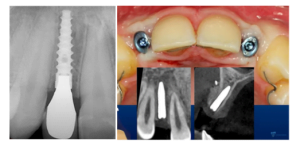
- Contraindications for bone grafting. Unfortunately, such cases are also not uncommon. To comply with a bone thickness on the facial (≥1.8mm) and inner side (≥1 mm), experts need to use implants of a smaller diameter. In such cases, we recommend using the dental implant design with the external hexagon, as described above.
Let’s sum up
- Implants with a diameter of less than 4mm are not recommended to be placed on a daily basis. They are highly specialized products for special cases.
- The main “workhorse”, especially for the masticatory section, is a root implant with a diameter of 4.5-5.0mm and a length of 10-12 mm.
- If the alveolar bone width does not allow placing an implant of 4.5mm wide following the recommendations that there should be a sufficient bone thickness around the implant rod, then bone grafting is recommended to extend the width of the alveolar crest.
- For special cases, there are narrow implants made of high-strength titanium alloys or designed with an external hexagon.
We hope this article was useful for you. ‘Till next article.
-
Hot
-
Hot
10 X UV11 Dental Implant Pure&Porous + 50% off Surgical Kit or Set of drills
Original price was: $1,180.$944Current price is: $944. Buy Now


